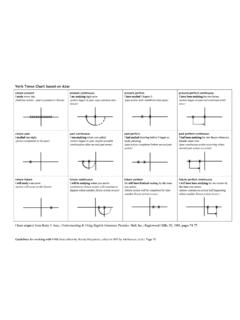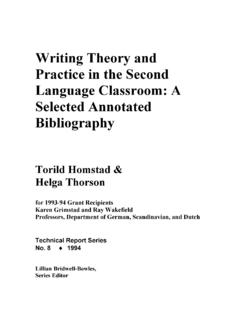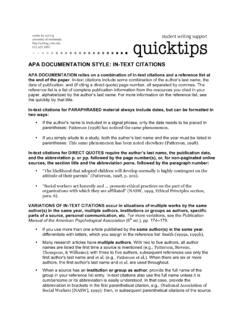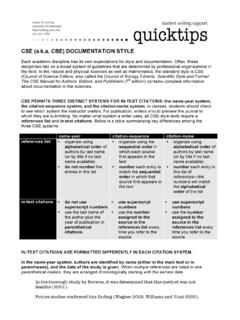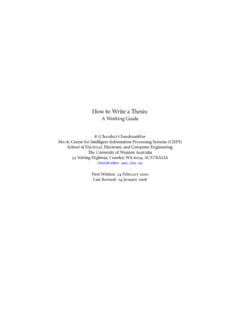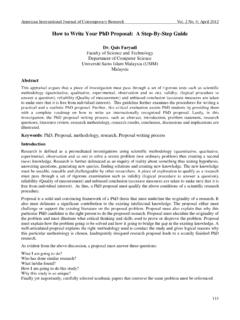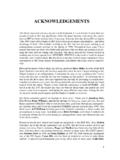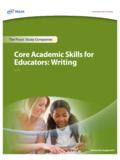Transcription of ACADEMIC ESSAY STRUCTURES & FORMATS
1 ACADEMIC ESSAY STRUCTURES & FORMATS Standard American argumentative essays begin with an introduction that gives a main point ( thesis ). The thesis is supported by a series of body paragraphs with sub-points, and the ESSAY ends with a conclusion. Below is a visual representation of this structure , adapted from the Seattle University Writing Center; on the back is an example of the typical format for an ACADEMIC paper. paper idea diagramtopic: _____introduction: _____subtopics - supporting arguments: _____details:_____conclusion: _____ (continued on next page) ACADEMIC Paper format Here is an example of what an ACADEMIC paper typically looks like.
2 Using standard fonts, margins, and indentations helps your paper gain credibility with an ACADEMIC audience; readers who are comfortable with your paper s format can pay close attention to the ideas you re communicating. Writer s Name WRIT 1201 Professor s Name September 20, 2007 Writing an Organized Paper The ability to write a well-organized and insightful paper is very important in order to be successful at the University of Minnesota. Most classes require at least one written assignment, and professors expect a high level of writing skill.
3 A good paper generally includes a thesis , paragraphs that support it, and a strong conclusion. A good thesis is integral to any ACADEMIC paper and should work as a general summary of the argument or main point of the paper. The thesis needs to be clear, and it should outline the main points to be discussed. Sometimes just making a list of the basic things you plan to write about and then compiling them into a sentence is enough. The rest of the paper should then follow the plan laid out by the thesis . In order for readers to be able to follow the logic of a paper, each paragraph should be related to what was introduced in the thesis .
4 A good way to start is by making a topic sentence to begin each paragraph. The topic sentence is often an extended or elaborated version of some part of the thesis statement. For example, this paper s thesis mentions paragraphs that follow [the thesis ], and the topic sentence for this paragraph expands on that idea. The rest of a paragraph should include evidence to support or explain the topic sentence. Once readers have been led through the paragraphs that support your main point, they will expect to find a solid conclusion that discusses the significance of what they have just read.
5 If the thesis predicts the main point of the paper, then the conclusion emphasizes the importance of your main point in some larger context. In the case of this paper, a conclusion might point out that following the general guidelines for presenting your ideas in an ACADEMIC setting allows your papers to make an impact on readers. Readers appreciate your presenting a paper in a way that s familiar to them; in turn, they are more likely to be open to your unique perspective. Write your name, the course, the instructor s name, and the date here (unless your instructor says otherwise).
6 Some papers include a title that suggests the topic. ACADEMIC papers often include a thesis in the first paragraph. In general, each paragraph should start with a topic sentence. Every paragraph begins with an indentation of five spaces (created with the tab or return/enter key). Papers are typically in 12 point Times New Roman font with double spacing and one-inch margins all around. Note how the ends and beginnings of paragraphs work to create a transition between ideas.





